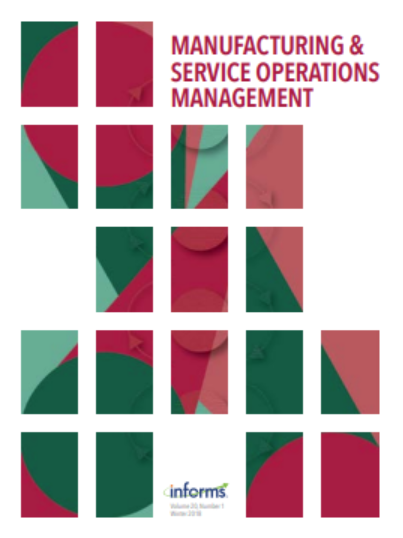驾驶员辅助问题:最后一英里配送的协调物流
IF 4.8
3区 管理学
Q1 MANAGEMENT
M&som-Manufacturing & Service Operations Management
Pub Date : 2023-09-25
DOI:10.1287/msom.2022.0211
引用次数: 1
摘要
问题定义:最后一英里交付是物流网络的关键组成部分,约占成本的30%-35%。随着运输量的增加,卡车路线的时间变得不可持续地长。为了解决这个问题,包括联邦快递(FedEx)和联合包裹(UPS)在内的许多物流公司都采用了“司机助手”来协助送货。助手可以通过两种方式帮助司机。作为“跳线员”,助手与司机一起准备和递送包裹,从而减少在给定站点的服务时间。作为一个“助手”,助手可以独立地在一个地点递送包裹,而司机可以离开到其他地点递送包裹,然后返回。给定一组交付地点、旅行时间、服务时间、跳线者节省的费用和助手的服务时间,目标是确定交付路线和使用助手(例如,有时作为跳线者,有时作为助手)的最有效方式,以最小化总路由时间。方法/结果:我们将此问题建模为具有指数变量数量和指数约束数量的整数程序,并提出分支削减和价格方法来解决它。我们的计算实验是基于一个工业合作伙伴提供的真实世界数据和亚马逊发布的数据集建立的模拟实例。基于Amazon数据集的实例表明,这种新颖的操作平均可以减少35.8%的路由时间,节省22.0%的成本。更重要的是,我们的结果描述了这种新型操作模式可以显著节省路由时间和成本的条件。管理意义:我们的计算结果表明,当服务区域更密集,卡车速度更高(≥10英里/小时)时,具有跳线和辅助模式的驾驶员辅助最有效。结合经济分析,我们提出了经验法则(接近100%的准确性)来预测是否使用助手以及以哪种模式使用。根据经验,我们发现,超过50%的时间用于交付(相对于驾驶)的服务交付路线是提供最大效益的路线。这些路线的特点是交货地点密度高。补充材料:电子伴侣可在https://doi.org/10.1287/msom.2022.0211上获得。本文章由计算机程序翻译,如有差异,请以英文原文为准。
The Driver-Aide Problem: Coordinated Logistics for Last-Mile Delivery
Problem definition: Last-mile delivery is a critical component of logistics networks, accounting for approximately 30%–35% of costs. As delivery volumes have increased, truck route times have become unsustainably long. To address this issue, many logistics companies, including FedEx and UPS, have resorted to using a “driver aide” to assist with deliveries. The aide can assist the driver in two ways. As a “jumper,” the aide works with the driver in preparing and delivering packages, thus reducing the service time at a given stop. As a “helper,” the aide can independently work at a location delivering packages, and the driver can leave to deliver packages at other locations and then return. Given a set of delivery locations, travel times, service times, jumper’s savings, and helper’s service times, the goal is to determine both the delivery route and the most effective way to use the aide (e.g., sometimes as a jumper and sometimes as a helper) to minimize the total routing time. Methodology/results: We model this problem as an integer program with an exponential number of variables and an exponential number of constraints and propose a branch-cut-and-price approach for solving it. Our computational experiments are based on simulated instances built on real-world data provided by an industrial partner and a data set released by Amazon. The instances based on the Amazon data set show that this novel operation can lead to, on average, a 35.8% reduction in routing time and 22.0% in cost savings. More importantly, our results characterize the conditions under which this novel operation mode can lead to significant savings in terms of both the routing time and cost. Managerial implications: Our computational results show that the driver aide with both jumper and helper modes is most effective when there are denser service regions and when the truck’s speed is higher (≥10 miles per hour). Coupled with an economic analysis, we come up with rules of thumb (that have close to 100% accuracy) to predict whether to use the aide and in which mode. Empirically, we find that the service delivery routes with greater than 50% of the time devoted to delivery (as opposed to driving) are the ones that provide the greatest benefit. These routes are characterized by a high density of delivery locations. Supplemental Material: The e-companion is available at https://doi.org/10.1287/msom.2022.0211 .
求助全文
通过发布文献求助,成功后即可免费获取论文全文。
去求助
来源期刊

M&som-Manufacturing & Service Operations Management
管理科学-运筹学与管理科学
CiteScore
9.30
自引率
12.70%
发文量
184
审稿时长
12 months
期刊介绍:
M&SOM is the INFORMS journal for operations management. The purpose of the journal is to publish high-impact manuscripts that report relevant research on important problems in operations management (OM). The field of OM is the study of the innovative or traditional processes for the design, procurement, production, delivery, and recovery of goods and services. OM research entails the control, planning, design, and improvement of these processes. This research can be prescriptive, descriptive, or predictive; however, the intent of the research is ultimately to develop some form of enduring knowledge that can lead to more efficient or effective processes for the creation and delivery of goods and services.
M&SOM encourages a variety of methodological approaches to OM research; papers may be theoretical or empirical, analytical or computational, and may be based on a range of established research disciplines. M&SOM encourages contributions in OM across the full spectrum of decision making: strategic, tactical, and operational. Furthermore, the journal supports research that examines pertinent issues at the interfaces between OM and other functional areas.
 求助内容:
求助内容: 应助结果提醒方式:
应助结果提醒方式:


